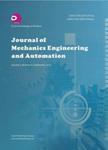Surface Roughness of Material Processing during Milling Process
Surface Roughness of Material Processing during Milling Process作者机构:Department of Machinery Industrial Faculty of Applied Technical Science University of Prishtina Mitrovica 40 000 Republic ofKosovo Department of Production and Automation/Technology of Production Faculty of Mechanical Engineering University of PrishtinaPrishtina 10 000 Republic of Kosovo
出 版 物:《Journal of Mechanics Engineering and Automation》 (机械工程与自动化(英文版))
年 卷 期:2012年第2卷第10期
页 面:601-605页
学科分类:08[工学] 080202[工学-机械电子工程] 0802[工学-机械工程] 080201[工学-机械制造及其自动化]
主 题:Milling machine surface roughness 2D and 3D surface parameters.
摘 要:To realize full automation in machining process, Computer Numerically Controlled (CNC) machine tools have been implemented during the past decades. The CNC machine tools require less operator input, provide greater improvements in productivity, and increase the quality of the machined part. End milling is the most common metal removal operation encountered. It is widely used to mate with other part in die, aerospace, automotive, and machinery design as well as in manufacturing industries. Surface roughness is an important measure of the technological quality of a product and a factor that greatly influences manufacturing cost. The quality of the surface plays a very important role in the performance of milling as a good-quality milled surface significantly improves fatigue strength, corrosion resistance, or creep life. Consequently, the desired surface roughness value is usually specified for an individual part, and specific processes are selected in order to achieve the specified finish. Purpose of the study is to develop a technique to predict a surface roughness of the part to be machined according to technological parameters. Such technique could be achieved by making mathematical model of machining. In this study as machining process the milling process is chosen, especially for end milling operation. Additionally to the study, one of the key factors, which differ from similar studies, is that as surface parameters the 2D, 3D surface parameters are used. In this study, all the surface parameters are expressed as 2D, 3D parameters. The 2D, 3D surface parameters give more precise figure of the surface; therefore it is possible to evaluate the surface parameters more precisely according to technological parameters. The result of the study, mathematical model of end-milling is achieved and qualitative analysis is maintained. Achieved model could help technologists to understand more completely the process of forming surface roughness.



